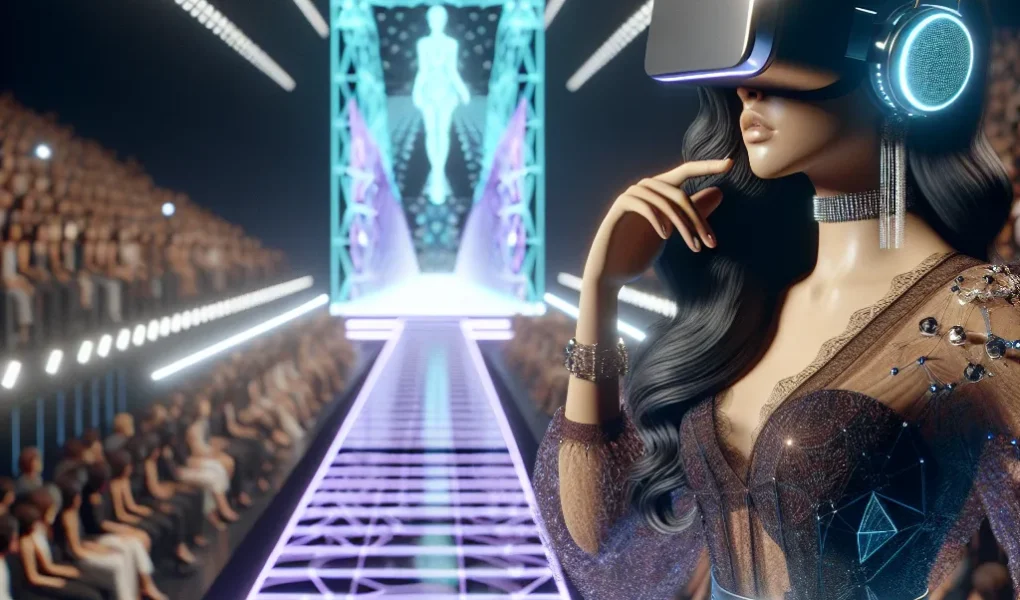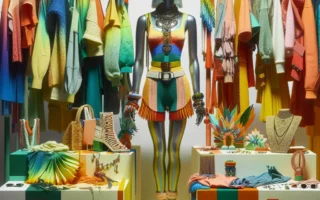Virtual Reality in Fashion Shows: Changing the Way We Experience Runway Events
Virtual Reality (VR) technology is revolutionizing the way we experience fashion shows by offering an immersive and interactive experience like never before. With the help of VR headsets, fashion enthusiasts can now attend runway events from the comfort of their homes, transcending geographical barriers and redefining the traditional fashion show experience.
One of the key advantages of VR in fashion shows is the ability to create a highly personalized and customized viewing experience. By donning VR headsets, users can feel as though they are sitting in the front row at a prestigious fashion event, observing the intricate details of the garments and experiencing the atmosphere as if they were physically present. This level of immersion not only enhances the engagement of the audience but also opens up new avenues for designers to showcase their collections in innovative and compelling ways.
Furthermore, VR technology enables fashion brands to experiment with creative concepts and themes that transcend the limitations of physical events. From surreal virtual environments to fantastical runway settings, VR empowers designers to unleash their imagination and present their collections in a manner that captivates and enthralls the audience.
In addition to revolutionizing the spectator experience, VR in fashion shows also holds immense potential for improving the efficiency of the industry. Through virtual showrooms and interactive presentations, designers can streamline the process of showcasing their collections to buyers and stakeholders, reducing the need for elaborate physical events and minimizing the associated costs and environmental impact.
As VR technology continues to evolve, its integration into fashion shows is poised to reshape the landscape of the industry, offering a platform for creativity, accessibility, and sustainability. By embracing virtual reality, fashion shows can transcend the boundaries of time and space, unlocking a new realm of possibilities that promise to shape the future of fashion trends.
In conclusion, Virtual Reality is not only changing the way we experience fashion shows, but also redefining the very essence of runway events, opening up a world of limitless potential for both creators and audiences alike.
Virtual Reality (VR) technology is revolutionizing the way we experience fashion shows by offering an immersive and interactive experience like never before. With the help of VR headsets, fashion enthusiasts can now attend runway events from the comfort of their homes, transcending geographical barriers and redefining the traditional fashion show experience.
3D Printing: Revolutionizing the Production of Customized Clothing
3D printing has emerged as a groundbreaking technology with the potential to revolutionize the production of customized clothing, shaping future fashion trends. This innovative technology enables designers and manufacturers to create unique, intricate designs that were once considered impossible to produce using traditional manufacturing methods. By utilizing 3D printing, fashion houses can offer personalized, made-to-measure garments that perfectly conform to an individual’s body shape and style preferences.
One of the key advantages of 3D printing in fashion is the ability to minimize material waste by only using the necessary amount of raw materials for production. This not only contributes to sustainable and eco-friendly practices but also reduces the overall production costs. Additionally, 3D printing allows for greater creative freedom and the exploration of unconventional materials, leading to the development of avant-garde and futuristic fashion pieces.
Moreover, the customization possibilities offered by 3D printing align perfectly with the growing consumer demand for unique and personalized products. With this technology, fashion designers can cater to individual tastes and sizes, breaking away from the standardization prevalent in the industry. As 3D printing continues to advance, it holds the potential to democratize fashion by empowering consumers to actively participate in the design and production of their clothing.
In conclusion, 3D printing is poised to significantly impact the future of fashion by allowing for the creation of customized, sustainable, and avant-garde clothing. As this technology evolves, it is likely to shape new fashion trends and pave the way for a more inclusive and innovative industry.
Smart Fabrics: How Technology is Redefining Comfort and Functionality in Fashion
Smart fabrics are revolutionizing the fashion industry, offering a glimpse into the future of clothing that seamlessly combines technology, comfort, and functionality. From temperature-regulating materials to biometric monitoring, these innovative textiles are paving the way for a new era of fashion.
One of the most striking aspects of smart fabrics is their ability to adapt to the wearer’s needs. Whether it’s a fabric that adjusts its porosity to enhance breathability or one that responds to changes in temperature, these textiles are redefining the concept of comfort in clothing. This integration of technology into the very fibers of the fabric is reshaping the way we experience and interact with our garments.
Moreover, the functionality of smart fabrics goes beyond mere comfort. With the incorporation of conductive threads and embedded sensors, clothing can now monitor physiological data, track biometric information, and even provide haptic feedback. This opens up a plethora of opportunities for creating clothing that not only looks great but also actively contributes to our well-being.
As technology continues to evolve, so too will the capabilities of smart fabrics. It’s clear that these innovative materials are not just a passing trend, but rather a key driver in shaping the future of fashion. By seamlessly blending technology, comfort, and functionality, smart fabrics are propelling the industry towards a new era of clothing that is as intelligent as it is stylish.
Artificial Intelligence and Fashion Design: The Integration of Data and Creativity
Artificial Intelligence (AI) is revolutionizing the fashion industry by integrating data and creativity to shape future trends. The integration of AI in fashion design has propelled the industry into a new era of innovation and efficiency. By analyzing vast amounts of data from various sources such as social media, runway shows, and consumer behavior, AI enables fashion professionals to gain profound insights into emerging trends and consumer preferences.
One of the most compelling aspects of AI in fashion design is its ability to optimize the creative process. AI algorithms can process enormous volumes of historical and real-time data to identify patterns, colors, and styles that are resonating with consumers. This empowers designers to make more informed decisions and enhances their ability to forecast future trends with accuracy.
Additionally, AI is facilitating the customization of fashion products by leveraging consumer data to offer personalized recommendations and designs. This level of personalization not only enhances the overall shopping experience for consumers but also enables brands to strengthen customer loyalty and satisfaction.
Furthermore, AI is streamlining the supply chain and manufacturing processes by optimizing inventory management, forecasting demand, and even generating designs. This not only reduces operational costs but also minimizes waste, contributing to a more sustainable and environmentally conscious fashion industry.
In conclusion, the integration of AI in fashion design is reshaping the future of the industry by seamlessly blending data and creativity. As AI continues to advance, its impact on fashion trends and consumer experiences will undoubtedly be transformative, propelling the industry into an era of unprecedented innovation and personalization.
Augmented Reality Fitting Rooms: Enhancing the Retail Experience
Innovative Technology Shaping Future Fashion Trends: Augmented Reality Fitting Rooms
As technology continues to evolve, it has become a driving force in shaping the future of fashion. One of the most intriguing advancements is the introduction of augmented reality (AR) fitting rooms in the retail sector. This innovative technology is revolutionizing the way consumers experience and interact with fashion, ultimately enhancing the overall retail experience.
AR fitting rooms allow customers to virtually try on clothing and accessories without physically having to put them on. By simply using a smartphone or AR device, shoppers can see how different outfits look on them in real time, complete with the ability to adjust sizes, colors, and styles. This not only saves time but also provides an immersive and personalized shopping experience.
Furthermore, AR fitting rooms enable retailers to gather valuable data regarding customer preferences and behaviors. By analyzing this information, fashion brands can better understand their target audience and tailor their offerings accordingly, leading to more effective marketing strategies and improved customer satisfaction.
Incorporating augmented reality into fitting rooms is also a game-changer for e-commerce. Online shoppers can now enjoy a more interactive and confident purchasing process, reducing the likelihood of returns and enhancing overall customer trust in the brand.
Overall, the introduction of AR fitting rooms is a testament to how technological innovations are shaping the future of fashion retail. By providing a seamless and engaging experience for consumers, augmented reality is proving to be a powerful tool in enhancing the way we shop for clothing and accessories.
Sustainable Fashion Tech: Innovations Driving Eco-Friendly Practices
As the fashion industry continues to evolve, innovative technologies are playing a pivotal role in shaping future trends. One of the most significant developments is the emergence of sustainable fashion tech, which encompasses a range of innovations driving eco-friendly practices within the industry. From sustainable materials and recycling techniques to advanced production processes, these technologies are reshaping the way fashion is created, consumed, and disposed of.
Sustainable fashion tech is driving the adoption of eco-friendly materials such as organic cotton, hemp, recycled polyester, and innovative vegan leather alternatives. These materials not only reduce the environmental impact of clothing production but also address ethical concerns related to animal welfare. Furthermore, advancements in textile recycling technologies are enabling the fashion industry to minimize waste and embrace circularity by repurposing old garments into new creations.
Another key aspect of sustainable fashion tech is the development of cutting-edge production methods that prioritize energy efficiency and reduce water consumption. Technologies such as 3D knitting, zero-waste pattern cutting, and on-demand manufacturing are revolutionizing the way clothing is produced, leading to significant reductions in the industry’s carbon footprint. Additionally, the integration of blockchain technology is enhancing supply chain transparency, allowing consumers to trace the origins of their garments and verify their sustainability credentials.
Overall, sustainable fashion tech is driving a fundamental shift towards more environmentally conscious practices within the fashion industry. By harnessing these innovative technologies, fashion brands and consumers alike have the opportunity to embrace a greener, more sustainable approach to style without compromising on creativity or quality.
Blockchain in Fashion: Transforming Transparency and Supply Chain Management
The fashion industry is rapidly evolving, embracing innovative technologies to drive transparency and efficiency. One such technology making significant strides is blockchain, which is revolutionizing transparency and supply chain management in the fashion sector. By leveraging blockchain, fashion brands can enhance trust and traceability throughout the entire supply chain, addressing key issues such as counterfeit products and unethical labor practices.
Blockchain technology enables the creation of secure, immutable records of every transaction and movement of goods, from sourcing raw materials to the final product. This level of transparency empowers consumers to make more informed purchasing decisions, as they can verify the authenticity and ethical origins of the products they buy. Furthermore, blockchain facilitates real-time tracking of inventory, reducing the likelihood of overstocking and minimizing wastage.
Implementing blockchain in fashion not only fosters a more ethical and transparent industry but also streamlines supply chain management processes. Smart contracts powered by blockchain can automate and enforce agreements between different parties, such as manufacturers, suppliers, and distributors. This automation can lead to cost savings and streamlined operations, ultimately benefiting both businesses and consumers.
In conclusion, the integration of blockchain technology in the fashion industry is reshaping the way brands manage their supply chains and how consumers perceive and interact with fashion products. As this transformative technology continues to mature, we can expect a future where transparency, ethical sourcing, and supply chain efficiency are the norm rather than the exception in the world of fashion.



